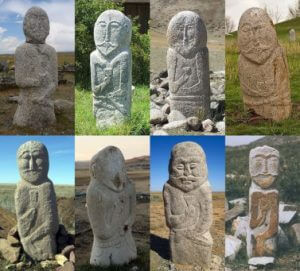 2
2

Product quality: deliberate "cartridges"
 02. 05. 2024
02. 05. 2024



 2
2

 02. 05. 2024
02. 05. 2024
 1
1

 01. 05. 2024
01. 05. 2024

 30. 04. 2024
30. 04. 2024

 10. 08. 2017
10. 08. 2017

Compared to the settled tribes and peoples, the ancient steppe nomads have left us with no more extensive cultural reference. They did not have permanent dwellings, and they did not use ceramics to break through.
Nevertheless, in the Eurasian steppes we can meet their civilization. These are stone statues that stand as guards in the wide steppes from Ukraine to Mongolia. Turkic and Mongolian nomadic tribes had various burial rituals - they buried in the ground, burned or left the bodies of their dead in the branches of trees.
Around 628 AD, the customs of Turkish nomads changed and instead of cremation, graves began to be dug. Some of them were left unmarked, and among them, surprisingly, was the resting place of Genghis Khan. On the contrary, they erected stelae, stone statues (balbal).
The name balbal comes from the languages of the nations that lived in the steppe areas (today the Ukrainian, Russian and Kazakh steppes). It is assumed that the basis is the word baba, which in Turkish languages means father or ancestor. Balbales can be made of stone or wood and are sunk into the ground. They usually have the shape of a human figure and most of the statues are in the range of 0,5 - 1 meter.
 Female sculptures occur significantly more often than male or those of indeterminate sex. Some sculptures are more primitive, have a flat body and only hinted facial features. Other balbales are much more elaborate. Some hold a cube in their hands, others have a weapon attached to their waist, and others wear jewelry such as earrings. Experts believe that the sculptures made in more detail are from a later period.
Female sculptures occur significantly more often than male or those of indeterminate sex. Some sculptures are more primitive, have a flat body and only hinted facial features. Other balbales are much more elaborate. Some hold a cube in their hands, others have a weapon attached to their waist, and others wear jewelry such as earrings. Experts believe that the sculptures made in more detail are from a later period.
Although there are a large number of balballs in the steppes, scientists are unable to come to a unanimous view of what to display. The most widespread version claims that these are tombstones that were erected where prominent members of the nation were buried. According to another theory, this is a depiction of an enemy who has been defeated or killed in battle. Others believe that stone sculptures are cult objects that have magical powers. In southern Kazakhstan, locals still offer sacrifices to ballballs to appease spirits.
In the 10th century, the number of erected stone sculptures began to decline sharply, mostly in the steppes of Central Asia. Experts explain this with the advent of Islam, which forbids the depiction of man. However, the balballs of previous centuries have been preserved and are a testament to the area's pre-Islamic culture. Unfortunately, they are currently declining because they are broken, stolen or completely destroyed. The Kazakh historian Alkai Margulan spoke about this problem in the last century and pointed out the importance of preventing the disappearance of the legacy of ancient nomads.